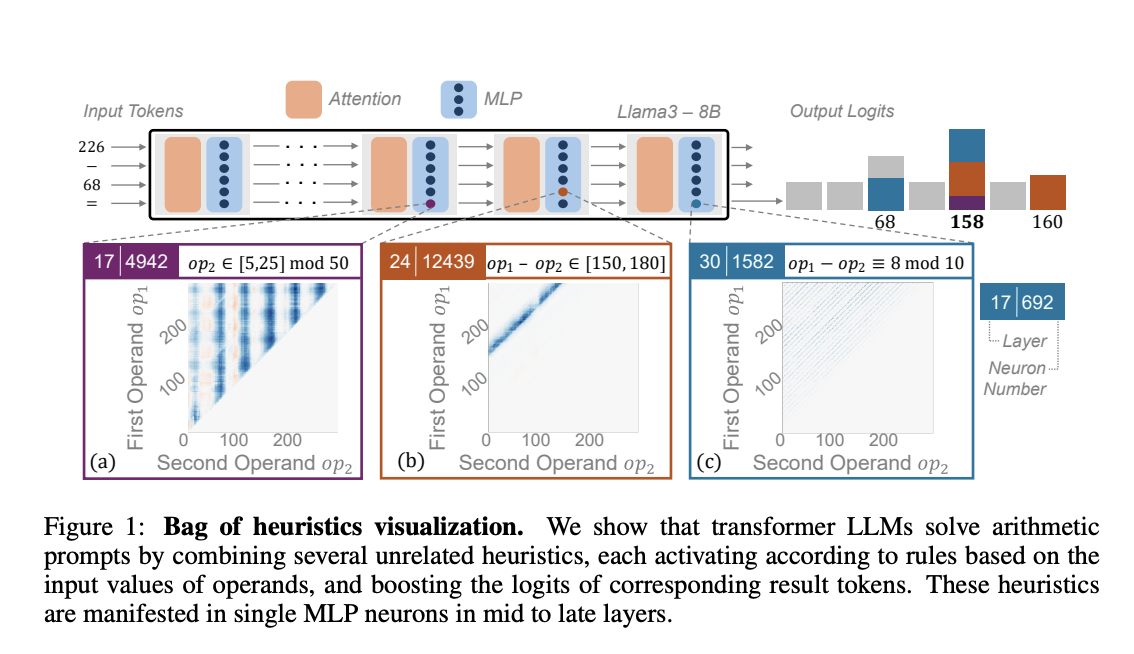
Understanding LLMs and Their Reasoning Abilities
A major question about Large Language Models (LLMs) is whether they learn to reason by developing transferable algorithms or if they just memorize the data they were trained on. This difference is important because while memorization might work for familiar tasks, true understanding allows for better generalization.
Key Insights on Arithmetic Reasoning
Arithmetic reasoning tasks can help determine if LLMs use learned algorithms, like humans do with vertical addition, or if they depend on memorized patterns. Recent studies have identified specific parts of models that are linked to arithmetic, suggesting that certain features assist in addition tasks. However, the complete understanding of how generalization versus memorization works is still being explored.
Mechanistic Interpretability (MI)
Mechanistic interpretability aims to break down language models to understand how their components function. Techniques like activation and path patching connect specific behaviors to parts of the model. Research is ongoing to see if LLMs generalize or memorize, with findings indicating that internal activations can show this balance. In arithmetic reasoning, new research highlights general structures in arithmetic circuits but emphasizes the need to understand how data is processed for accuracy.
Research Findings on LLMs and Arithmetic
Researchers from Technion and Northeastern University found that LLMs use a “bag of heuristics” rather than strong algorithms or pure memorization for arithmetic tasks. By analyzing neurons in arithmetic circuits, they discovered that specific neurons respond to simple patterns, like operand ranges, to generate correct answers. This heuristic approach develops early in training and remains a key method for solving arithmetic problems.
Understanding Circuit Components
In transformer-based models, a circuit consists of specific components that perform tasks like arithmetic. Researchers examined the arithmetic circuits in several models (Llama3-8B/70B, Pythia-6.9B, and GPT-J) to find which components are responsible for arithmetic operations. They identified crucial MLPs and attention heads that aid in answer prediction, noting that only about 1.5% of neurons per layer are needed for high accuracy.
Heuristic-Driven Reasoning
To solve arithmetic prompts, models utilize a “bag of heuristics,” where individual neurons recognize specific patterns, contributing to the probability of correct answers. Neurons are categorized by their activation patterns, and each type is responsible for different arithmetic tasks. Tests confirm that each heuristic type significantly impacts the prompts aligned with its pattern. This suggests that arithmetic skills mainly arise from these coordinated heuristic neurons throughout training.
Implications for AI Development
The study indicates that LLMs rely on heuristic-driven reasoning rather than robust algorithms or simple memorization. By identifying specific components responsible for arithmetic, researchers found that these neurons activate for particular input patterns, working together to support accurate responses. This heuristic approach starts early in training and evolves over time. Improving LLMs’ mathematical abilities may require fundamental changes in training and architecture beyond current methods.
Get Involved
Check out the paper for more insights. All credit goes to the researchers involved. Follow us on Twitter, join our Telegram Channel, and connect with our LinkedIn Group. If you appreciate our work, subscribe to our newsletter and join our 55k+ ML SubReddit community.
Transform Your Business with AI
Stay competitive by leveraging insights from the research on arithmetic reasoning in LLMs. Here’s how AI can redefine your work:
- Identify Automation Opportunities: Find key customer interaction points that can benefit from AI.
- Define KPIs: Ensure your AI initiatives have measurable impacts on business outcomes.
- Select an AI Solution: Choose tools that fit your needs and allow for customization.
- Implement Gradually: Start with a pilot project, gather data, and expand AI usage wisely.
For AI KPI management advice, contact us at hello@itinai.com. For ongoing insights into leveraging AI, follow us on Telegram t.me/itinainews or Twitter @itinaicom.
Discover how AI can enhance your sales processes and customer engagement. Explore solutions at itinai.com.






















